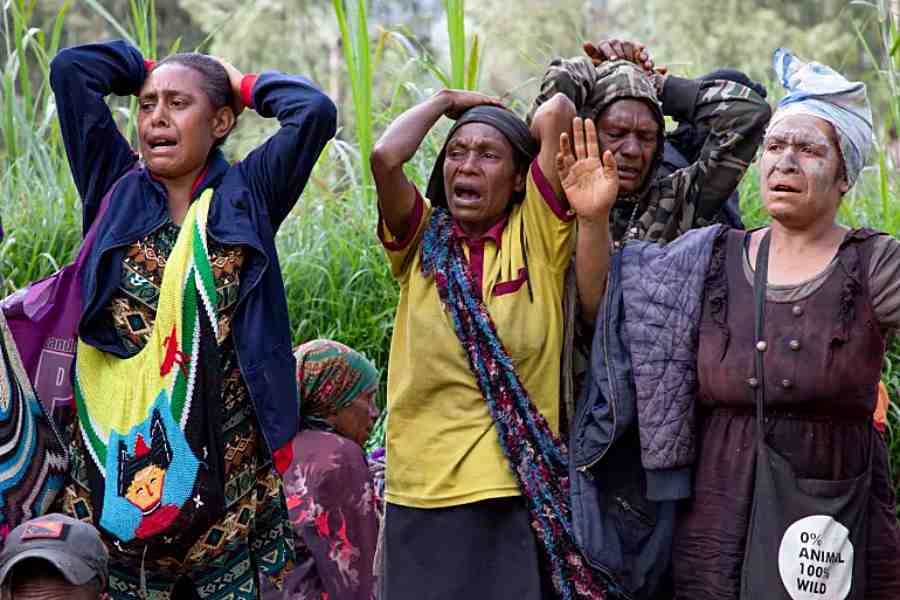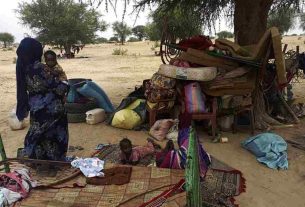![]() Some 2,000 people are thought to have been buried when mud and rocks gave way in the early hours of Friday morning [UNDP via AFP]
Some 2,000 people are thought to have been buried when mud and rocks gave way in the early hours of Friday morning [UNDP via AFP]
Wed 05 June 2024:
Papua New Guinea has officially halted the search for approximately 2,000 people buried under a massive landslide in Enga province, authorities said on Wednesday.
Much of the area’s water flows through the landslide site – now a 600 metre-long (1,970 feet) graveyard of a still undetermined number of people.
The disaster management committee declared Tuliparo village, engulfed by the landslide, a “mass cemetery,” local media reported, adding the decision came after acknowledging the near-impossibility of retrieving the bodies.
Earlier, the UN migration agency drew attention to the operational challenges in the area, saying there are fuel shortages and security issues.
 A satellite image shows a closer view of the landslide in Yambali village, Enga province, Papua New Guinea on Monday [Handout: Maxar Technologies/Reuters]
A satellite image shows a closer view of the landslide in Yambali village, Enga province, Papua New Guinea on Monday [Handout: Maxar Technologies/Reuters]
Neighboring Australia and New Zealand announced $4 million in humanitarian assistance to the landslide-hit country.
The UN’s children’s agency said about 40 percent of those affected were children under the age of 16 who had been “deeply traumatised”.
The landslide occurred on May 24, burying homes, infrastructure, and farmland under up to eight meters of soil and debris. The Oceanian government estimates indicate that 2,000 people may have been buried under the soil.
Enga provincial administrator Sandis Tsaka acknowledged that PNG, one of the Asia Pacific’s poorest countries, was not equipped to deal with the scale of the tragedy.
It is unclear how many people were living in the hillside community in dense tropical rainforest when the landslide hit.
The last official census was 24 years ago.
The population of the small roadside community had reportedly swelled in recent months and years, Glenn Banks, professor of geography at Te Kunenga Ki Purehuroa: Massey University in New Zealand, told Al Jazeera.
People had moved to the area in the hopes of finding gold in the open pit and waste dumps of the nearby Porgera gold mine, said Banks, whose research focuses on mining in Papua New Guinea.
He added that the mine was about 20-30km (12-19 miles) from the landslide, meaning that it had had “a direct effect” on “the stability of the ground along the road”.
The number of people living in the area may also have grown after dozens of people were killed in tribal fighting in February, Banks noted.
More than 25,000 people have been displaced by tribal fighting in Enga province, according to the International Organization for Migration (IOM), including at least 5,453 people displaced in February and March this year alone.
Landslides becoming more common
Enga province is one of several mountainous highlands regions in PNG that form part of the third largest rainforest on earth after the Amazon and the Congo Basin rainforest.
Papua New Guineans, who have long grown yams, cassava, bananas, and taro in the mountains, are increasingly having to contend with a changing climate as well as logging and forest clearance by international mining, timber and palm oil companies.
The tropical forests’ dense trees helped to prevent landslides because their roots held the soil together, said Alan Collins, professor of geology at The University of Adelaide.
“Deforestation can make landslides more prevalent by destroying this biological mesh,” he said.
Rainfall can also weaken rocks and can destabilise the ground, Collins added.
Papua New Guinea is ranked as the world’s 16th most at-risk country to climate change and natural hazards, according to the 2022 World Risk Index, even though it is only responsible for about 0.11 percent of global greenhouse gas emissions.
The mountains in Enga province are also unstable due to their proximity to the edges of the Australian and Pacific continental plates, Collins added.
“Although this landslide does not appear to have been directly triggered by an earthquake, the frequent earthquakes caused by plates colliding build steep slopes and high mountains that can become very unstable,” he said.
SOURCE: INDEPENDENT PRESS AND NEWS AGENCIES
______________________________________________________________
FOLLOW INDEPENDENT PRESS:
WhatsApp CHANNEL
https://whatsapp.com/channel/0029VaAtNxX8fewmiFmN7N22
![]()
TWITTER (CLICK HERE)
https://twitter.com/IpIndependent
FACEBOOK (CLICK HERE)
https://web.facebook.com/ipindependent
YOUTUBE (CLICK HERE)
https://www.youtube.com/@ipindependent
Think your friends would be interested? Share this story!





